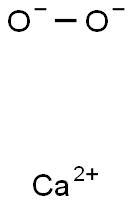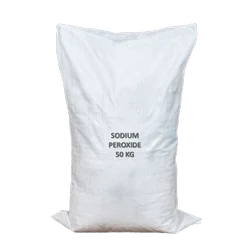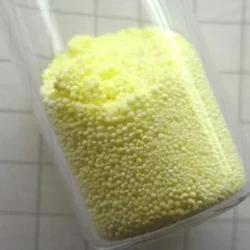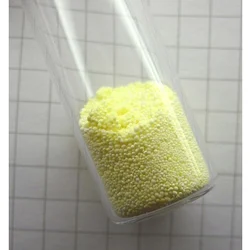Sodium peroxide
Synonym(s):Sodium peroxide;Sodium superoxide
- CAS NO.:1313-60-6
- Empirical Formula: Na2O2
- Molecular Weight: 77.98
- MDL number: MFCD00003497
- EINECS: 215-209-4
- SAFETY DATA SHEET (SDS)
- Update Date: 2025-09-25 17:15:13

What is Sodium peroxide?
Description
Sodium peroxide has a molecular formula of Na2O2 and is an inorganic peroxide salt. It is a yellowish-white powder that turns yellow when heated. Sodium peroxide absorbs water and carbon dioxide from the air and is soluble in cold water. It is a strong oxidizing agent, is corrosive and can cause burns to the eyes and skin, and is also toxic by ingestion and inhalation. Sodium peroxide is water reactive and a dangerous fire and explosion risk in contact with water, alcohol, or acids. Sodium peroxide forms self-igniting mixtures with powdered metals and organic materials. It is incompatible with ethyl or methyl alcohol, glacial acetic acid, carbon disulfide, glycerin, ethylene glycol, and ethyl acetate. The four-digit UN identification number is 1504. The NFPA 704 designation is health 3, flammability 0, and reactivity 1. The 704 diamond has the prefix “oxy” in the white space at the bottom. It is used as bleach and as an oxygen-generating material for diving bells and submarines.
Chemical properties
Sodium peroxide, Na202, is a fire-hazardous white powder that yellows when heated and causes ignition when in contact with water. Sodium peroxide is decomposed by heating, although this is not easily accomplished. It is stable in dry air; however, in moist air,or when acted on by water, it decomposes readily. It can be a powerful oxidizer and a powerful reducing agent, depending on conditions. Sodium peroxide is also used as a bleach, in medicine soap, and in the decomposition of minerals.
Chemical properties
Sodium peroxide, Na2O2, is a pale yellow solid, stable at ambient temperature, and hygroscopic. On heating, it starts to liberate oxygen at about 300 °C and decomposes rapidly above its melting point of 460 °C.
The Uses of Sodium peroxide
Sodium peroxide historically was used to bleach wood pulp for the production of paper and textiles. It is mainly used for specialized laboratory operations, for example, the extraction of minerals from various ores. Sodium peroxide is used as an oxidizing agent and is used as an oxygen source by reacting with carbon dioxide to produce oxygen and sodium carbonate; it is thus particularly useful in scuba gear, submarines, and so on.
The Uses of Sodium peroxide
Bleaching animal and vegetable fibers, feathers, bones, ivory, wood, wax, sponges, coral; rendering air charged with CO2 respirable as in torpedo boats, submarines, diving bells, etc.; purifying air in sick rooms; dyeing and printing textiles; chemical analysis. General oxidizing agent.
The Uses of Sodium peroxide
As an oxidizing agent, a bleaching agent, deodorant, pharmaceuticals and dyes, and as an analytical reagent.Sodium peroxide acts as a bleaching agent in laundry and wood pulp. It finds application in the extraction of minerals from various ores. It acts as an oxidizing agent as well as an oxygen source by reacting with carbon dioxide. Furthermore, it is used as a deodorant and an analytical reagent. It is also useful in scuba gear and in submarines.
What are the applications of Application
Sodium peroxide is a powerful oxidizing compound used in laboratory applications
Definition
Exists as impurity (about 10%) in sodium peroxide, obtained by heat- ing sodium peroxide in oxygen, reacts with water to yield hydrogen peroxide, oxygen, and sodium hydroxide.
Definition
sodium peroxide: A whitish solid(yellow when hot), Na2O2, soluble inice-water and decomposed in warmwater or alcohol; r.d. 2.80; decomposesat 460°C. A crystalline octahydrate(hexagonal) is obtained bycrystallization from ice-water. Thecompound is formed by the combustionof sodium metal in excess oxygen.At normal temperatures itreacts with water to give sodiumhydroxide and hydrogen peroxide.It is a powerful oxidizing agent reactingwith iodine vapour to give theiodate and periodate, with carbon at300°C to give the carbonate, andwith nitrogen(II) oxide to give thenitrate. It is used as a bleachingagent in wool and yarn processing,in the refining of oils and fats, andin the production of wood pulp.
General Description
A yellow-white to yellow granular solid. Mixtures with combustible material are readily ignited by friction, heat, or contact with moisture. May vigorously decompose under prolonged exposure to heat, causing the rupture of the containers.
Air & Water Reactions
Reacts vigorously with water, large amounts react explosively [Haz. Chem. Data 1969. p. 201].
Reactivity Profile
Sodium peroxide reacts violently with reducing agents, combustible materials and light metals. Reacts exothermically and rapidly or even explosively with water to form a strong base (NaOH) and oxygen (O2) [Handling Chemicals Safely 1980 p. 854]. A mixture with ammonium persulfate can explode if subjected to friction (crushing in a mortar), if heated, or if a stream of gaseous carbon dioxide is passed over Sodium peroxide [Mellor 10:464 1946-47]. Reacts very vigorously with gaseous hydrogen sulfide; even in the absence of air, the reaction may be accompanied by flame [Mellor 10:132 1946-47]. An explosion results when gaseous carbon dioxide is passed over a mixture of Sodium peroxide with powdered magnesium [Mellor 2:490 1946-47] . Mixtures with acetic acid or acetic anhydride can explode if not kept cold [Von Schwartz 1918 p. 321]. Spontaneously flammable in contact with aniline, benzene, diethyl ether, or organic materials such as paper and wood. Mixtures with charcoal, glycerine, certain oils, and phosphorus burn or explode [Mellor 2:490 1946-47]. A mixture with calcium carbide (powdered) burst into flame when exposed to damp air and exploded when heated [Mellor 2:490 1946-47]. Decomposes, often violently in the presence of catalytic quantities of manganese dioxide [Mellor 2 Supp. 2:635 1961]. Mixing with sulfur monochloride leads to a violent reaction [Mellor 2 Supp. 2:634 1961]. Can react with and cause the ignition of fuels.
Hazard
Dangerous fire and explosion risk in contact with water, alcohols, acids, powdered metals, and organic materials. Strong oxidizing agent. Keep dry. Irritant.
Health Hazard
TOXIC; inhalation or contact with vapor, substance, or decomposition products may cause severe injury or death. Fire will produce irritating, corrosive and/or toxic gases. Runoff from fire control or dilution water may cause pollution.
Fire Hazard
May ignite combustibles (wood, paper, oil, clothing, etc.). React vigorously and/or explosively with water. Produce toxic and/or corrosive substances on contact with water. Flammable/toxic gases may accumulate in tanks and hopper cars. Some may produce flammable hydrogen gas upon contact with metals. Containers may explode when heated. Runoff may create fire or explosion hazard.
Flammability and Explosibility
Not classified
Safety Profile
A severe irritant to shin, eyes, and mucous membranes. Dangerous fire hazard by chemical reaction; a powerfuloxidizing agent. Reacts explosively or violently under the appropriate conditions with water, acids, powdered metals, acetic acid, acetic anhydride, Al, (Al + CO2), aluminum + aluminum chloride, almond oil, (NH4)2S208, aniline, Sb, As, benzene, boron nitride, calcium aceqlide, charcoal, Cu, cotton wool, (KNO3 + dextrose), diethyl ether, fibrous materials + water, glucose + potassium nitrate, hexamethylene-tetramine, hydrogen sulfide, hydroxy compounds (e.g., ethanol, ethylene glycol, glycerol, sugar), magnesium, (Mg + CO2), MnO2, metals, metals + carbon dioxide + water, nonmetals (e.g., carbon, phosphorus, antimony, arsenic, boron, sulfur, selenium), nonmetal halides (e.g., diselenium dichloride, disulfur dichloride, phosphorus trichloride), organic matter, paraffin, K, silver chloride + charcoal, soap, Na, sodium dioxide, SCl, Sn, Zn, wood, peroxyformic acid, reducing materials. Will react with water or steam to produce heat and toxic fumes. To fight fire, use carbon dioxide or dry chemical. Combustible materials ignited by contact with sodium peroxide should be smothered with soda ash, salt or dolomite mixtures. Chemical fire extinguishers should not be used. If the fire cannot be smothered, it should be flooded with large quantities of water from a hose. When heated to decomposition it emits toxic fumes of Na2O. See also SODIUM HYDROXIDE and PEROXIDES, INORGANIC.
Properties of Sodium peroxide
| Melting point: | 460 °C (dec.)(lit.) |
| Boiling point: | 657°C |
| Density | 2.8 |
| vapor pressure | 0.001Pa at 20℃ |
| Flash point: | 657°C |
| storage temp. | Store at +15°C to +25°C. |
| solubility | Soluble in acid. Insoluble in alkali. |
| form | beads (small) |
| color | Yellow |
| Specific Gravity | 2.805 |
| PH | 12.8 (100g/l, H2O, 20℃) |
| Odor | Odorless |
| PH Range | 12.8 |
| Water Solubility | Soluble in water, forming NaOH and H{2}O{2}. Soluble in acid. Insoluble in alkali. |
| Sensitive | Air Sensitive & Hygroscopic |
| Merck | 14,8655 |
| Dielectric constant | 2.7(Ambient) |
| Stability: | Reacts violently with water. Contact with combustible materials may cause fire or explosion. Incompatible with strong oxidizing agents, alcohols, organic materials, acids, powdered metals. Absorbs carbon dioxide from the air. |
| CAS DataBase Reference | 1313-60-6(CAS DataBase Reference) |
| EPA Substance Registry System | Sodium peroxide (1313-60-6) |
Safety information for Sodium peroxide
| Signal word | Danger |
| Pictogram(s) |
 Flame Over Circle Oxidizers GHS03  Corrosion Corrosives GHS05 |
| GHS Hazard Statements |
H271:Oxidising liquids;Oxidising solids H314:Skin corrosion/irritation |
| Precautionary Statement Codes |
P210:Keep away from heat/sparks/open flames/hot surfaces. — No smoking. P220:Keep/Store away from clothing/…/combustible materials. P260:Do not breathe dust/fume/gas/mist/vapours/spray. P280:Wear protective gloves/protective clothing/eye protection/face protection. P303+P361+P353:IF ON SKIN (or hair): Remove/Take off Immediately all contaminated clothing. Rinse SKIN with water/shower. P305+P351+P338:IF IN EYES: Rinse cautiously with water for several minutes. Remove contact lenses, if present and easy to do. Continuerinsing. |
Computed Descriptors for Sodium peroxide
Sodium peroxide manufacturer
Zama Chemical
New Products
4,4-Difluoropiperidine hydrochloride tert-butyl 9-methoxy-3-azaspiro[5.5]undecane-3-carboxylate Indole Methyl Resin N-Isopropylurea N,N-Dicyclohexylcarbodiimide(DCC) MELDRUMS ACID 5-METHYLISOXAZOLE-4-CARBOXYLIC ACID Magnessium Bis glycinate Zinc ascorbate 1-bromo-2-butyne 2-acetamidophenol 9(10H)-anthracenone Erythrosin B, 4-Piperidinopiperidine 2-((4-morpholinophenylamino) (methylthio) methylene) malononitrile 2,4-dihydroxybenzaldehyde 3-(4-morpholinophenylamino)-5-amino-1H-pyrazole-4-carbonitrile Methyl 2-methylquinoline-6-carboxylate 2,6-dichloro-4-nitropyridine 4-Bromo-2-chlorobenzonitrile 2-(benzylamino)acetic acid hydrochloride 4-(tert-Butoxycarbonylamino)but- 2-ynoic acid 3,4-dihydro-2H-benzo[b][1,4]dioxepine 1-Phenyl-1-cycloprppanecarboxylicacidRelated products of tetrahydrofuran








You may like
-
 Sodium peroxide, For analysis ACS CAS 1313-60-6View Details
Sodium peroxide, For analysis ACS CAS 1313-60-6View Details
1313-60-6 -
 Sodium peroxide, For analysis ACS CAS 1313-60-6View Details
Sodium peroxide, For analysis ACS CAS 1313-60-6View Details
1313-60-6 -
 Sodium peroxide, For analysis ACS CAS 1313-60-6View Details
Sodium peroxide, For analysis ACS CAS 1313-60-6View Details
1313-60-6 -
 Sodium Peroxide ACS CAS 1313-60-6View Details
Sodium Peroxide ACS CAS 1313-60-6View Details
1313-60-6 -
 Sodium Peroxide Powder / Crystals / LumpsView Details
Sodium Peroxide Powder / Crystals / LumpsView Details
1313-60-6 -
 Sodium Peroxide Granular ARView Details
Sodium Peroxide Granular ARView Details
1313-60-6 -
 Sodium Peroxide Granular ARView Details
Sodium Peroxide Granular ARView Details
1313-60-6 -
 Sodium Peroxide PowderView Details
Sodium Peroxide PowderView Details
1313-60-6
